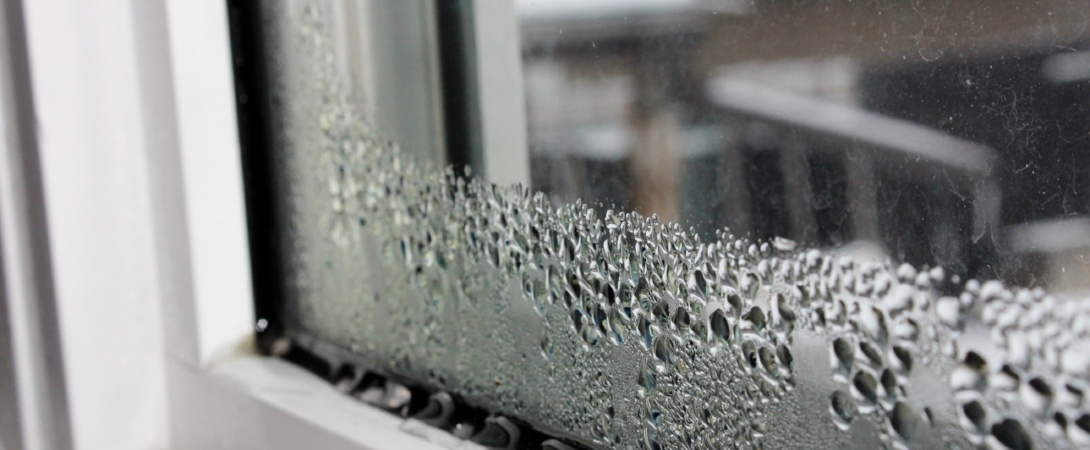Have you ever tried to clean a window that appeared dirty, only to realize that the problem is actually between the panes of glass, not on them? It’s a common issue, and one that many people experience—a fogged window due to a failed window seal.
A fogged window is certainly nothing to panic about. It’s not a structural issue of any kind, and your electricity bills won’t suddenly shoot up. But it can be annoying, and it can negatively impact the enjoyment of your home or building.
What causes fogged window glass?
So, why do you see foggy glass when a window seal fails? It starts with the types of windows used in new construction today. Most buildings have double or triple paned insulated windows (as opposed to single pane windows, which are typically only found on older buildings or outbuildings). Each pane offers an extra insulating layer between you and the outdoors. Between the panes is a layer of air or clear, odorless gas. Double and triple pane windows are great at protecting homes and buildings from the cold during the winter and keeping the A/C inside during the summer.
As great as double and triple pane windows are, the sealed environment is not perfect. Temperature changes, wind, water, and other factors all have an impact on the life of a window seal. Of course windows will be exposed to the elements during their lifecycle—that’s the whole point of windows! So it’s inevitable that, given enough time, window seals will eventually fail.
When one of the seals on an insulated window fails, moist air is allowed to seep between the panes, where it condenses. You might not even notice that the seal has failed for a while, because the “fog” may not be visible. Only after there has been a fairly rapid change in temperature will you see evidence of a failed seal. But when you do start to notice, you’ll see either condensation or hazy-looking glass. If the window fogs over enough times, you may start to see a mineral deposit on the glass that makes it look dirty all the time.
Your options: repair or replace?
Tired of dealing with a fogged window with a broken seal? You have a few different options for fixing the problem.
Option 1: Replace the Entire Window
The first solution to consider is replacing your entire window. While this is a total fix and will certainly eliminate the fogging problem, it is the most expensive solution. Budget is one of the biggest factors people consider when buying replacement windows. Depending on the brand, material, and style you choose, your costs could differ. There are two different procedures for replacement windows:
- Insert Replacements (Lower Cost): Reuse all interior and exterior trim; new windows fit inside the existing window frame. Quick install and minimal materials required.
- Full Tear-Out (Higher Cost): All new trim inside and out; new windows fit inside the stud (rough opening). Much longer installation and more materials required.
Option 2: Replace the Sash
If your windows have removable sashes, you may be able to keep the existing framework in place. For example, if you have a double-hung window, both the sash and the frame move up and down, and the sash is removable. Replacing the sash is typically less expensive than total window replacement. Ask your window repair company whether they will replace sashes only.
Option 3: Replace the Glass Units
The third option is to have just the glass units of the windows replaced. This involves carefully removing the existing panes, cleaning the frame, and placing new glass in the opening. This option is typically the most cost-effective and reasonable solution to a failed glass seal situation, especially since no painting or staining is required.
Something to keep in mind for each for these replacement options: companies may charge a higher fee on a per-window basis if you are only replacing one or two windows, versus volume discounts if you are replacing many windows.
Bonus Option: Do Nothing
There is actually a fourth option available to you…do nothing!
The drawback of letting your window fog continue is that you’ll have impaired views and a lower energy value—although windows with failed seals actually retain their energy better than you might think. Still, you’ll need to decide for yourself whether you’re comfortable living with a foggy window that always looks dirty. While you may be okay with just one or two foggy windows, eventually the problem may be too frustrating to ignore.
What’s the best option?
This article from the Family Handyman sums it up well:
“When windows fog and fail, the only viable option is replacement. It’s extremely difficult to separate the old panes, clean them up and reseal them again: The glass becomes “etched” from minerals in the moist air, the old seals are difficult to remove in order to get a tight new seal and a repair is just not cost effective. And the heck of it is, there’s not much you can do to prevent window failure.”
The best defense against a fogged, failed window is to start with a high-quality window with a long warranty.
One final note to consider: checking for failed window seals is not required in home inspections. One reason for this is that if the window has an insect screen or is dirty, fogged glass may not be fully visible. So, if you’re in a home inspection scenario, know that the inspector won’t be specifically looking for failed window seals—something to consider if you’re thinking of buying or selling your house!
Do you have fogged windows that need to be dealt with? Contact Acme Glass to get guidance on your options.
If you’re ready to start a new project or renovation, get in touch with us by phone, online, or stop in today!
Mon-Fri: 8:00am – 5:00pm
Sat: 9:00am – 1:00pm
